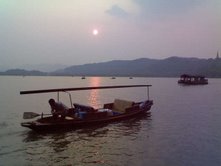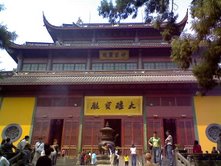
![]()
|
Index
•
|
|
Welcome
•
|
|
21st Century•
The Future |
|
World
Travel•
Destinations |
|
Reviews•
Books & Film |
|
Dreamscapes•
Original Fiction |
|
Opinion
& Lifestyle •
Politics & Living |
|
Film
Space •
Movies in depth |
|
Kid's
Books •
Reviews & stories |
|
|
|
|
The International Writers Magazine: China Travels
We arrived at Hangzhou airport after the short flight from Beijing. Hangzhou airport is located 15km to the north of the town and is easily accessible by bus. When we arrived the sky was dark grey and it was raining heavily, this was rather depressing but an interesting change from Beijing. Due to fairly heavy traffic, something I’d hoped we would leave behind in Beijing it took about 40 minutes to reach central Hangzhou. In the doom and gloom Hangzhou’s suburbs seemed depressing and lifeless, the few people we saw were crouched under raincoats faceless in the darkness. However, when we entered the bright neon lights of central Hangzhou our disappointment changed to curiosity and excitement.
Hangzhou Pilgrimage
• Paul Haire
Hangzhou is firmly established as a favourite destination for the Chinese traveler and as a result it can be a busy place to visit. However, this needn’t deter you from visiting what is one of the prettiest and most historic cities in China. A few months ago, my girlfriend and I chose to visit Hangzhou for a weekend break.
We left the bus and looked for a taxi to our hotel, central Hangzhou is typical of most Chinese cities nowadays, full of bright shopping centres and fancy restaurants located side by side with old bicycle repair shops and local eateries, there seemed to be nothing particularly distinguishing about it except the fact that it was on a slightly smaller scale than Beijing.
The town itself is situated on the north eastern side of lake Xi Hu, the major attraction of Hangzhou, and our hotel was located on the south eastern edge of the lake. We checked in and went to explore. The rain had thankfully stopped, we wandered around a modern shopping and eating complex which nestled by the lake side, we walked through little archways, over quaint stone bridges spanning brightly lit ponds decorated with fountains and little waterfalls. Everything sparkled in the reflected puddles on the pavement. As it was dark, the lake for the moment simply seemed like a mass vacuum of space with only a few signs of life over on the far side, indicated by lights twinkling forlornly, it was very romantic. We wandered past Starbucks and various cosy looking restaurants, cafes and little boutiques. After having dinner in a nearby restaurant we headed back to the hotel.
The next day, we decided to hire some bikes to see around lake Xi Hu. There are numerous bike rental shops located in Hangzhou, and prices are generally reasonable, though remember to check the bikes are in good condition before you set off, we had a nasty, and yet also quite amusing, incident in the evening when the pedal fell off my girlfriends bike halfway down one of Hangzhou’s main streets.
We cycled anti-clockwise round lake Xi Hu and I recalled what Marco Polo had said about ‘A voyage on this lake offers more refreshment and pleasure than any other experience on earth..’ I maybe wouldn’t go that far, but it was very nice. It was a beautiful sunny day thankfully unlike the previous evening though this meant that the lake was very busy, especially as this was the weekend, though cycling was the perfect way to explore. The surrounding area around the lake comprised of pleasant hills covered in lush woodland. On the lake many people were enjoying boat trips on human propelled gondola’s which looked vaguely similar to those found in Venice if slightly larger and more oriental. This seemed to be an excellent way to escape the crowds and just soak up the tranquil atmosphere, though unfortunately our budget did not stretch far enough to include this pleasure this time around. We cycled past a seven storeyed pagoda nestled snugly on top of a small hill, it was pretty and sat there looking down on Hangzhou and the throngs of people promenading around the lake.
We cycled on and came to Song Di, one of two causeways which cross the lake and which give an excellent view back to Hangzhou town and also of the surrounding hills. Couples and families strolled along enjoying the pleasant environment and leisurely atmosphere. It was slightly less crowded here and much quieter. The large number of families enjoying themselves meant that it felt slightly reminiscent of a beach resort in Victorian England where whole families would go to the coast for their holidays before traveling abroad became affordable. We reached the other side of the lake, the northern shore, which contains a number of temples including Baoshu Ta and an important daoist temple Baopu Compound where old men were practicing calligraphy and young girls were playing some kind of traditional instrument. We carried on round back into the urban area of Hangzhou admiring the views back to the causeway we had just crossed and the other smaller causeway Bai Di which connected the only island on the lake, Gu Shan, to the shore. The causeway’s marble arches reminded me of the seventeen arched bridge at the summer palace .
We headed to the ‘Old street’ for dinner and to soak up the atmosphere, (this was when the pedal incident occurred). The street was a modern reproduction of a traditional Hangzhou thoroughfare. I had been a little hesitant to come as many of these type of reconstructions that I’ve been to in other Chinese cities are sterile and unrealistic, though I was pleasantly surprised by Hangzhou’s. It seemed to capture the hustle and bustle and authenticity of another era. There were puppeteers, traditional teahouses and restaurants and of course the obligatory hawkers selling touristy items. We ate some street food for dinner and wandered around enjoying the atmosphere. As it was Saturday night it was very crowded. We soon came to the last shop as the street wasn’t too long, so we then went to a food festival that was going on nearby. There were hundreds of food stalls selling food from all around China and Asia and a group of dancing Arabs in sunglasses selling big chunks of meat on skewers. The atmosphere was good and with families and couples out enjoying Saturday night. We then headed back to the bikes to take them to a bike repair shop to reattach the offending pedal and my girlfriend found she had lost the key to the bike locks. Oh what fun, I began to regret having hired the bikes at all! We found a bike repair shop closeby thankfully and soon all was ok. We headed back to the hotel to relax after a pleasant day exploring the lake and central Hangzhou.
We passed a few Buddhist monks paying their respects to Buddha and giving alms to a man with deformed limbs, who was hoping for some compassion from tourists in this most holy of Buddhist sites. We headed up past the carvings and the monks who were admiring them and came to the main temple. Lingyin Si is one of the biggest temple complexes in China, in the past it housed over three thousand monks.
The next day we headed to the Hangzhou’s most famous temple, Lingyin Si which is located three kilometers west of Hangzhou. Rock carving’s of Buddha adorn the cliffs to the left of the steep pathway leading to the monastery. The carvings number in the hundreds and cover a wide are of the mountainside, some date from between the tenth and fourteenth centuries and are the most important of their kind in southern China, you can wander on the slightly precipitous pathways, (those afraid of heights or wearing flip flops beware!) into caves and in and around boulders as you look down upon those walking on the ordinary path, who were too scared to clamber up the cliff side!
The temple complex is extensive, containing many buildings. Though only the main temples are open to the public in what is still a working place of worship. We saw a few more monks and nuns, (one who looked like the reincarnation of the laughing Buddha) who had made the pilgrimage from all over Asia. The temple has been restored over 16 times due to the frequent wars that have occurred in China and most of the statues including the eighteen metre high carving of Sakyamuni which was made out of camphor wood are relatively new reproductions. The temple’s main body is situated on a steeply rising hillside with lots of steps to climb. In the Hall of the Heavenly King there were brightly coloured statues the ‘Guardians of the four directions’, which grimace fiercely down upon you protecting the temple from evil spirits and terrifying young children. The temple was full of people praying and lighting incense, others were resting outside after climbing up the steep steps which led from one building to the next. The architectural style was distinctively southern Chinese, the tiles at the corner of the rooves curved sharply upward. The temple buildings themselves were coloured a pale yellow colour unlike the deep terracotta red of Beijing’s Yonghegong, and they blended harmoniously with the natural surroundings of light green pines with pale brown trunks, rough clumps of grey white granite and light brown dusty earth. We descended back down the hill after spending about an hour and a half looking around the temple and headed back to the town.
After one final wander along the lake front and a quick pizza in Pizzahut that oh so traditional Hangzhou food, we grabbed a taxi and headed to the airport. We had missed the last bus apparently, even though it was only around 6 o’clock in the evening. There are many other sites to see around Hangzhou, which we did not have time to visit such as the Longjing tea estate, where you can see where one of the most famous teas in China is made. Hupaomeng Quan a natural spring which was apparently, according to legend started by a ninth Century, Zen Buddhist monk and two tigers. Though the real pull of Hangzhou still remains Xi Hu lake and the tranquil atmosphere it lends to the whole city.
Hangzhou is a popular tourist destination and is easily accessible from Beijing, though during Summer and on weekends it is extremely busy. However, if you feel like a romantic weekend or just somewhere to relax and get away from it all, lazing on a boat in the middle of lake Xi Hu at sunset is not a bad place to be.
© Paul Haire March 2007
paulhaire@hotmail.com
Visiting a Chinese sauna with my student…..steamy!
Paul Haire
One of my students who I teach English to recently invited me to a sauna to see a show and have dinner. I was slightly apprehensive
Drab Beijing a sleeping giant
Paul Haire
Beijing can be a pretentious place, made up of drab apartment blocks, smog and traffic jams.
More Travel Stories
Home© Hackwriters 1999-2007
all rights reserved - all comments are the writers' own responsibiltiy - no liability accepted by hackwriters.com or affiliates.

